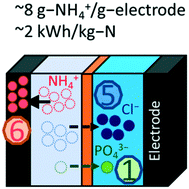Recovery of ammonium and phosphate using battery deionization in a background electrolyte†
Abstract
Ammonium ions can be effectively removed from water using electrochemical processes such as battery electrode deionization (BDI), but previous tests have examined removal in the presence of competing ions (e.g. sodium). The recovery of NH4+ was examined here in the absence and presence of a relatively inert background electrolyte (MgCl2, 10 mM) added to only provide a conductive solution with cations that have minimal intercalation into the copper hexacyanoferrate (CuHCF) electrodes. The capacity of the CuHCF electrodes for NH4+ in the presence of MgCl2 was nearly constant at 8.4 ± 1.4 g-NH4+/g-electrode (treated stream, 0.3 V) over a range of 10 to 100 mM NH4Cl. In addition, the energy needed to remove NH4+ was constant at <2.4 kW h per kg-N. The impact of Cl− on removal of phosphate ions was also examined, with ∼2 : 1 removal of Cl− to phosphate ions (Cl : P) at ratios of up to 4 : 1. Even at very high ratios of >11.5, at least 20% of the anions removed were phosphate ions compared to Cl−. These results demonstrate that the capacity of the BDI electrodes is relatively independent of the NH4+ concentration, and that phosphate is not selectively removed compared to Cl−.



 Please wait while we load your content...
Please wait while we load your content...